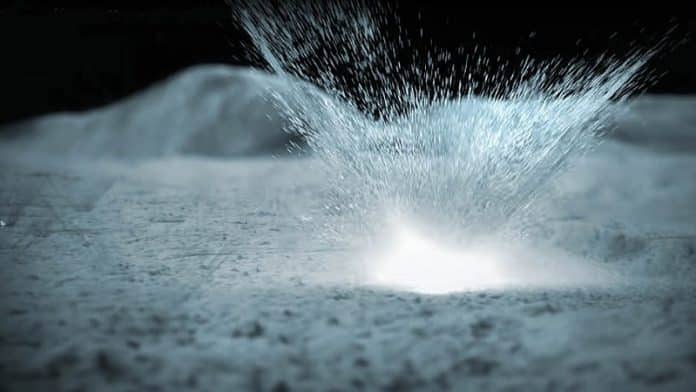NASA: Meteoroid strikes splash water out of the lunar surface
Researchers from NASA and the Johns Hopkins University Applied Physics Laboratory in Laurel, Maryland, confirmed that meteoroid strikes were releasing water from the Moon, according to data collected by NASA’s Lunar Atmosphere and Dust Environment Explorer (LADEE).
“It’s raining… on the Moon?! Scientists have discovered that water is being released on the lunar surface during meteor showers” NASA tweeted along with a video.
It’s raining … on the Moon?! ?
Scientists have discovered that water is being released on the lunar surface during meteor showers. Get more details: https://t.co/wgtXyXnjMA pic.twitter.com/iK28nAlGiR
— NASA (@NASA) June 7, 2019
For those unaware, LADEE (Lunar Atmosphere and Dust Environment Explorer) was a NASA lunar exploration and technology demonstration mission that orbited the Moon from October 2013 to April 2014 to collect comprehensive information about the structure and composition of the thin lunar atmosphere.
To confirm the findings, NASA Goddard, a space institute run by the organization, also published a four-minute video ‘Water Released from Moon.’
In the past, models assumed that meteoroid strikes could eject water from the Moon in vapor form; however, scientists hadn’t observed this occurrence until LADEE’s mission.
“We traced most of these events to known meteoroid streams, but the really surprising part is that we also found evidence of four meteoroid streams that were previously undiscovered,” said Mehdi Benna of NASA’s Goddard Space Flight Center in Greenbelt, Maryland, and the University of Maryland Baltimore County in a press release.
The newly identified meteoroid streams, detected by LADEE, occurred on January 9, April 2, April 5 and April 9, 2014.
“The Moon doesn’t have significant amounts of H2O or OH in its atmosphere most of the time,” said Richard Elphic, the LADEE project scientist at NASA’s Ames Research Center in California’s Silicon Valley. “But when the Moon passed through one of these meteoroid streams, enough vapor was ejected for us to detect it. And then, when the event was over, the H2O or OH went away.”
LADEE, which was built and managed by NASA’s Ames Research Center in California’s Silicon Valley, noticed the vapor using its Neutral Mass Spectrometer, an instrument built by Goddard. The mission collected detailed information about the “exosphere” – a faint envelope of gases around the Moon.
NASA explained how meteoroid showers could release water on the Moon. To release water, the meteoroids had to penetrate at least 3 inches (8 centimeters) below the surface. Underneath this bone-dry top layer lies a thin transition layer, then a hydrated layer, where water molecules likely stick to bits of soil and rock, called regolith, according to the study.
“From the measurements of water in the exosphere, the researchers calculated that the hydrated layer has a water concentration of about 200 to 500 parts per million or about 0.02 to 0.05 percent by weight. This concentration is much drier than the driest terrestrial soil and is consistent with earlier studies. It is so dry that one would need to process more than a metric ton of regolith in order to collect 16 ounces of water,” the researchers noted.
“Because the material on the lunar surface is fluffy, even a meteoroid that’s a fraction of an inch (5 millimeters) across can penetrate far enough to release a puff of vapor. With each impact, a small shock wave fans out and ejects water from the surrounding area.”
When a stream of meteoroids rains down on the lunar surface, the liberated water will enter the exosphere and spread through it. About two-thirds of the vapor escapes into space, while one-third lands back on the surface of the moon, according to the study. Over the course of a year, meteorites set free about 300 metric tonnes of water from the moon’s soil.
These findings could help explain the deposits of ice in cold traps in the dark reaches of craters near the poles. Since most of the known water on the Moon is located in cold traps, water vapor will remain stable there for a long time due to the low temperatures.
Meteoroid strikes can transport water both into and out of cold traps. However, the team ruled out the possibility that all of the water discovered came from the meteoroids themselves.
“We know that some of the water must be coming from the Moon because the mass of water being released is greater than the water mass within the meteoroids coming in,” said the second author of the paper, Dana Hurley of the Johns Hopkins University Applied Physics Laboratory.
The analysis indicates that meteoroid impacts release water faster than it can be produced from reactions that occur when the solar wind hits the lunar surface.
“The water being lost is likely ancient, either dating back to the formation of the Moon or deposited early in its history,” said Benna.
The findings of the study have been published in Nature Geosciences which the scientists are hoping to use in the future to explore the history of water and its origins on the moon.
Source: NASA press release

